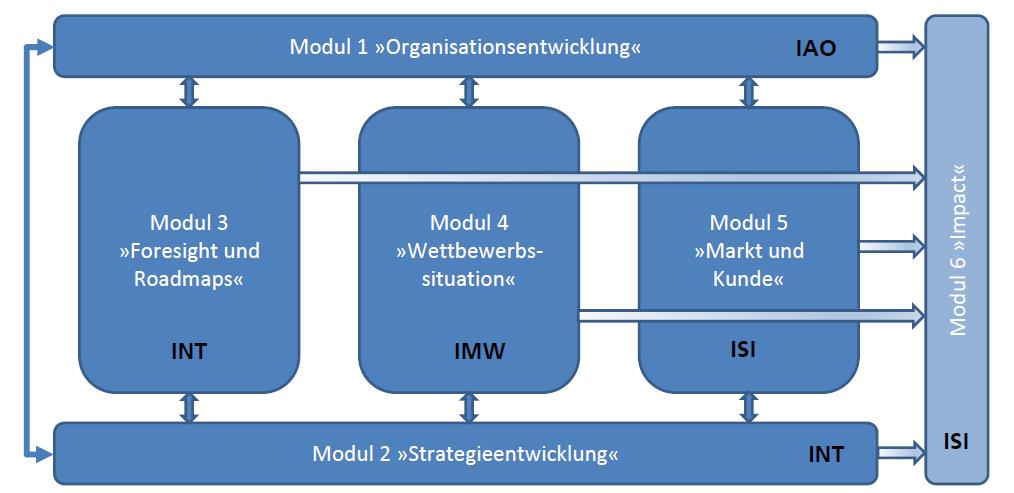Under the accompanying research project FRAME (FRAunhofer Microelectronics Innovation Enhancement), the Presidential Council of the Fraunhofer Gesellschaft is backing FMD with the Fraunhofer Group for Innovation Research. This Group is to support FMD’s work as a virtual organization platform for research and development. FRAME is underpinning FMD management in setting up the FMD office, and its support with methodology and personnel is helping to ensure FMD’s success.
FRAME is supporting FMD in these specific areas:
1. Business Development
a. Strategy Development
b. Organization Development
2. Methodological Support
a. Benchmarking & Best Practice
b. Methodological Support in the Strategy Process
c. Developing and Evaluating Questionnaires, Running Surveys
3. Innovation Analyses
a. Analyzing the FMD Environment (Competition, Foresight)
b. Determining Market Potential
c. Derivation of Recommended Actions
To distribute tasks among the institutes of the Fraunhofer Group for Innovation Research, the FRAME project is structured in different modules (see Fig. 1). Overall coordination of the project is in the hands of the Fraunhofer Institute for Systems and Innovation Research (ISI).
The “Strategy Development” Module
As part of the Strategy Development module, Fraunhofer INT supported FMD in the conceptual design and development of its “Strategic Research and Innovation Plan 2018.” As shown in Figure 2, INT carried out a systematic analysis of technological competences and application fields common to all 13 FMD institutes. The purpose was to identify common activities as strategic target corridors, and so point up the possibilities for future FMD offers with added value through cooperation (horizontal and vertical integration) (Portfolio Analysis – Fig. 3 gives an example). The written survey was structured in line with the Strategic Research Agenda (SRA) for Electronic Components and Systems 2018, to ensure that the strategy would work internationally1. Data collection was very successful (with a 100% return rate) at both Fraunhofer and Leibnitz.
Results from the strategic survey were combined with results from the systematic market and competitor analyses of the corresponding FRAME modules and then documented in the FMD “Strategic Research and Innovation Plan 2018”. Part of FMD’s interim evaluation, this initial FMD strategy document was submitted to BMBF at the end of 2018. It was very positively rated by BMBF, which matched FMD’s own rating.
Plans for the Strategy Module in 2019 are to continue deepening the analysis of survey data, conduct strategy workshops at all 13 FMD institutes, prepare a strategy update and to conduct a white-spot analysis of FMD.
The “Foresight and Roadmaps” Module
In a nutshell, the “Foresight and Roadmaps” module has the task of reviewing and analyzing FMD’s technological and social environment. As a time horizon, a period of about five to ten years and beyond was chosen. The goal is to prepare FMD to meet future challenges from technology and society.
The consequence for Fraunhofer INT is that several experts in TASP, the Technology Analysis and Strategic Planning Department, have evaluated literature on microelectronics with a view to possible technology trends. Additionally, technology topics already developed in other projects in the past have been consulted and updated. A multi-stage selection process produced a longlist of more than 60 trends. In internal workshops, this longlist was reduced to about 30 trends, forming a basis for further work in 2019. For each of these technology trends, a technology map was created which gave a general description of the topic, of its relevance to FMD, and of current developments. In addition, the prerequisites were created for expanding the technology maps in the future, for example with bibliometric analyses and possible recommendations for action. Accompanying this was a literature database containing relevant scientific articles and planning documents that were used for the technology trends.
Parallel to the work on technological trends, the Fraunhofer Institute for Systems and Innovation Research (ISI) considered and selected trends in society. Subsequently, these technological and social trends were combined into trend clusters, which also serve FMD as a basis for strategic, systematic preparation for future topics.
The next major step will be a workshop in 2019, where analysts from INT and ISI, together with FMD experts, will jointly be discussing and evaluating the social and technological trends found. The concept is to cluster the trends from different perspectives, for example on a time scale, according to fields of application, and FMD technology parks. The workshop will be based on the technology maps and clusters mentioned above, and, in turn based on workshop results, the challenges for FMD can be derived.
 Fraunhofer Institute for Technological Trend Analysis INT
Fraunhofer Institute for Technological Trend Analysis INT
